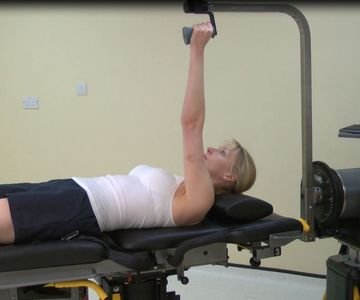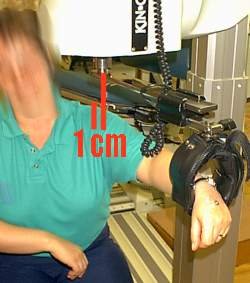These movements can be performed in either the lying or seated positions.
There are currently no standard examination positions for horizontal abduction and adduction of the shoulder. During the movements of the gleno-humeral joint there are always relative movements within the scapulo-thoracic junction. These are usually described as fitting a set of established normalpatterns. These must be considered when testing the shoulder. When testing or exercising the shoulder it is vital that the subject has sufficient warm up before performing any movements.
Lying position:
In the supine position (see below) stabilization is effectively achieved by the contact between the thorax and the bed. Testing in this position is more stabilised than in the seated position and allows full adduction.

To view a set up video see below:
Seated position:
This position is only available on a dynomometer with allot of height adjustment (KIn-Com). When using the seated position the thoracic belts should be utilized to prevent upper body movements. The position is inherently unstable so it is only recommended for patients and not for research.

Stabilisation:
Lying: Stabilisation in the lying position is not normally required as this is inherent in the position.
Seated: In the seated position stabilisation usually involves chest straps.
Attachments:
There is validity in using a wrist strap (as seen in seated above) rather than a grip handle (as seen in lying above) because this eliminates the influence of the wrist flexors and extensors. Although this may have some face validity it does not translate into real world testing. The hand grip is then always preferable.
Make sure the elbow has a small degree of flexion throughout the range to ensure it’s safety (5 degrees is usually enough).
Axis of rotation:
Regardless of the position of the test the alignment of the instantaneous axis of rotation should be approximately 1cm away from the mid line above the acromial process when the humerous is at a right angle to the body and the scapula is angled at 90degrees. But it has been shown by Walmsley (1993) that the gleno-humeral joint as a whole (never mind its instantaneous axis of rotation) moves by an average of 8cm through range so the need for accuracy must be questioned.
Anatomical zero:
With arm at 90 degrees to the thorax (in seated pointing straight ahead in lying pointing to the roof).
Range of motion:
Generally a large range of motion is chosen for these tests. Generally +40-60 degrees adduction to 90+ degrees abduction (depending on flexibility). Adduction is tested less often (as it actually reproduces a medical test designed to aggravated the acromio clavicular joint), however anything from 0-60 degrees can be used.
Gravity correction:
In lying position: As the lever arm can be very long and heavy in these movements setting of gravity correction is essential.
In sitting: Not required as gravity plays no role.
Speeds:
Generally it is accepted that speeds of 30 degrees/second and multiples of this should be used.
Shoulder Horizontal Abduction / Adduction Protocols:
Muscles involved:
Subscapularis, infraspinatus, supraspinatus, teres minor, latissimus dorsi, teres major and pectoralis major
| Strength Test Protocols | General | Patients | Athletes | Research |
| Contraction Cycle | con/con | con/con | con/concon/ecc | con/conecc/ecc |
| Speed/s | 60 or 90 | 30 or 60 | 30-300 | 30-500 |
| Trial Repetitions | 0 | 0 | 0 | 3 |
| Repetitions | 10 | 10 | 10 | 5 |
| Sets | 3 | 3 | 4 | up to 9 |
| Rest between sets | 20-30 secs | 20-30 secs | 20-30 secs | 20 secs |
| Rest between speeds | 2 minutes | 2 minutes | 2 minutes | 2-5 minutes |
| Rest between sides | 5 minutes | 5 minutes | 5 minutes | 5 minutes |
| Feedback | nil | nil | nil | nil |
| Endurance Test Protocols | General | Patients | Athletes | Research |
| Contraction Cycle | con/con | con/con | con/concon/ecc | con/conecc/ecc |
| Speed/s | 90 | 60 | 60-300 | 30-500 |
| Trial Repetitions | 0 | 0 | 0 | 0 |
| Repetitions | Max | Max | Max | Max |
| Sets | 1 | 1 | 1 | 1 |
| Rest between sets | N\A | N/A | N/A | N/A |
| Rest between speeds | 10-15 mins | 10-15 mins | 10-15 mins | 10-30 mins |
| Rest between sides | 5 mins | 5 mins | 5 mins | 5 mins |
| Feedback | nil | nil | nil | nil |
| Strength Exercise Protocol | General | Patients | Athletes |
| Contraction Cycle | con/con | con/con | con/ecc |
| Speed/s | 60 up to 180 | 30 up to 180 | 60-300 |
| Trial Repetitions | 0 | 0 | 0 |
| Repetitions | 10 | 10 | 14 |
| Sets | 6 | 6 | up to 12 |
| Rest between sets | 30-60 secs | 30-60 secs | 30 secs |
| Rest between speeds | 2 mins | 2 mins | 2 mins |
| Rest beween sides | Nil | Nil | Nil |
| Feedback | bar | bar | bar |
| Endurance Exercise Protocol | General | Patients | Athletes |
| Contraction Cycle | con/con | con/con | con/con |
| Speed/s | 60-180 | 60-180 | 60-300 |
| Trial Repetitions | 0 | 0 | 0 |
| Repetitions | Max | Max | Max |
| Sets | 1-3 | 1 | 1-3 |
| Rest between sets | 5-10 mins | N/A | 5-10 mins |
| Rest between speeds | 10-30 mins | N/A | 10-30 mins |
| Rest between sides | Nil | Nil | Nil |
| Feedback | bar/pie chart | bar/pie chart | bar/pie chart |
Notes:
Test the uninvolved or dominant limb first.
Interpretation:
In the shoulder it is normal to look at the ratio between the right and left sides there should be a 0-10% difference between the sides. Anything beyond this would either demonstrate extreme hand dominance (this can happen in certain sports like javelin), or indicate a muscle imbalance which would be best corrected.
Eccentric results are generally 30% higher than concentric within the same muscle.
Angle of peak torque for abduction is -28 degrees although this can vary to as little as -17 degrees with increasing speed (that is 28 degrees in abduction) (Lee and Chun 1991)
Angle of peak torque for adduction is -53 degrees although this can be as much as -89 dgrees (that is 53 degrees of abduction) (Lee and Chun 1991)
Normative values:
| Weir et al. (1992) | Age | Sex | Machine | Peak mean (SD) | Peak mean (SD) |
| speed deg/s | 15-18 | M | Cybex | Hor. Abduction | Hor. Adduction |
| 30 | 48.2 (10.4) | 51.4 (16.2) | |||
| 180 | 35.8 (10.7) | 35.6 (12.8) | |||
| 300 | 25.1 (9.3) | 23.8 (9.1) | |||
| Weir et al (1992) | 15-18 | M | Cybex | PTBW | PTBW |
| 30 | 0.32 | 0.34 | |||
| 180 | 0.24 | 0.24 | |||
| 300 | 0.17 | 0.16 | |||
| Lee and Chun. (1991) | Cybex | ftlbs Dominant | |||
| 60 | 37 | 22 | |||
| 180 | 28 | 14 | |||
| Power Dominant | |||||
| 180 | 66 | 27 | |||
Silva et al(2006) looked at shoulder horizontal adduction/abduction ratios and found the adductors are normally 2x the strength of the abductors:
| Alderink & Kuck (1986) | Dominant Side % (sd) | Non Dominant Side % (sd) | Average % |
| 30 | 0.82 (0.21) | 0.75 (0.21) | 0.79 (0.16) |
| 60 | 0.59 (0.17) | 0.56 (0.20) | 0.58 (0.16) |
| 90 | 0.47 (0.19) | 0.43 (0.15) | 0.45 (0.14) |